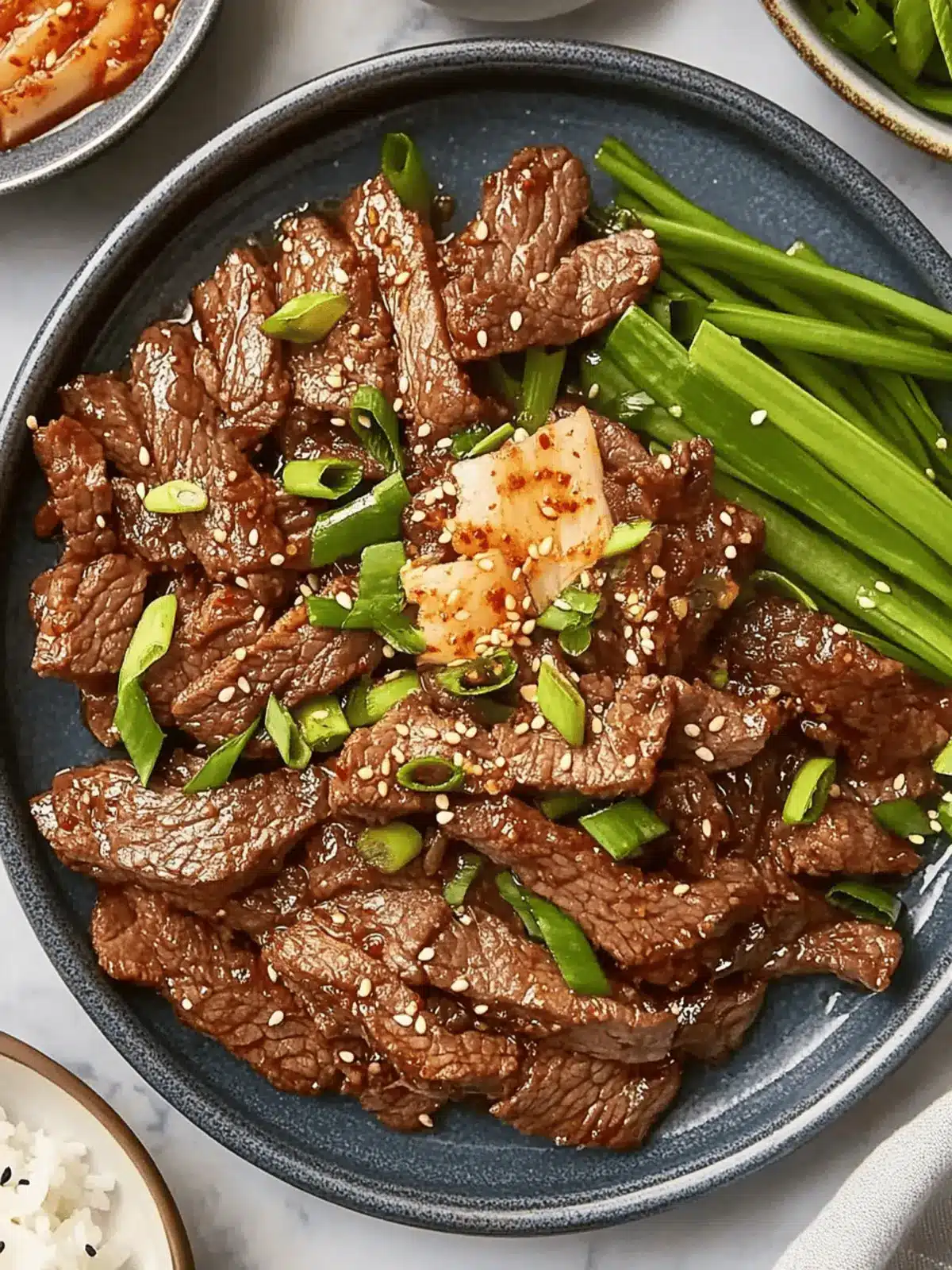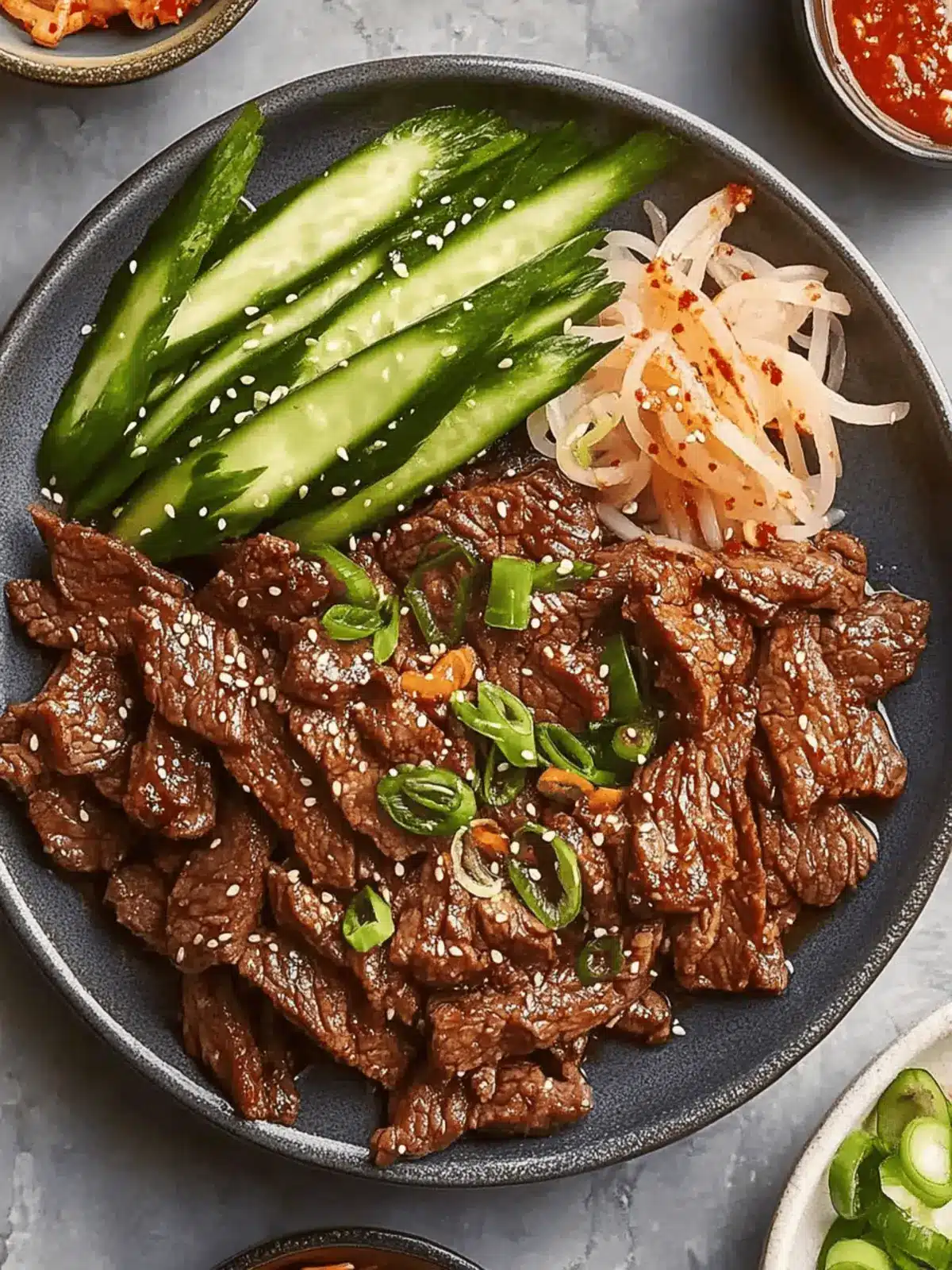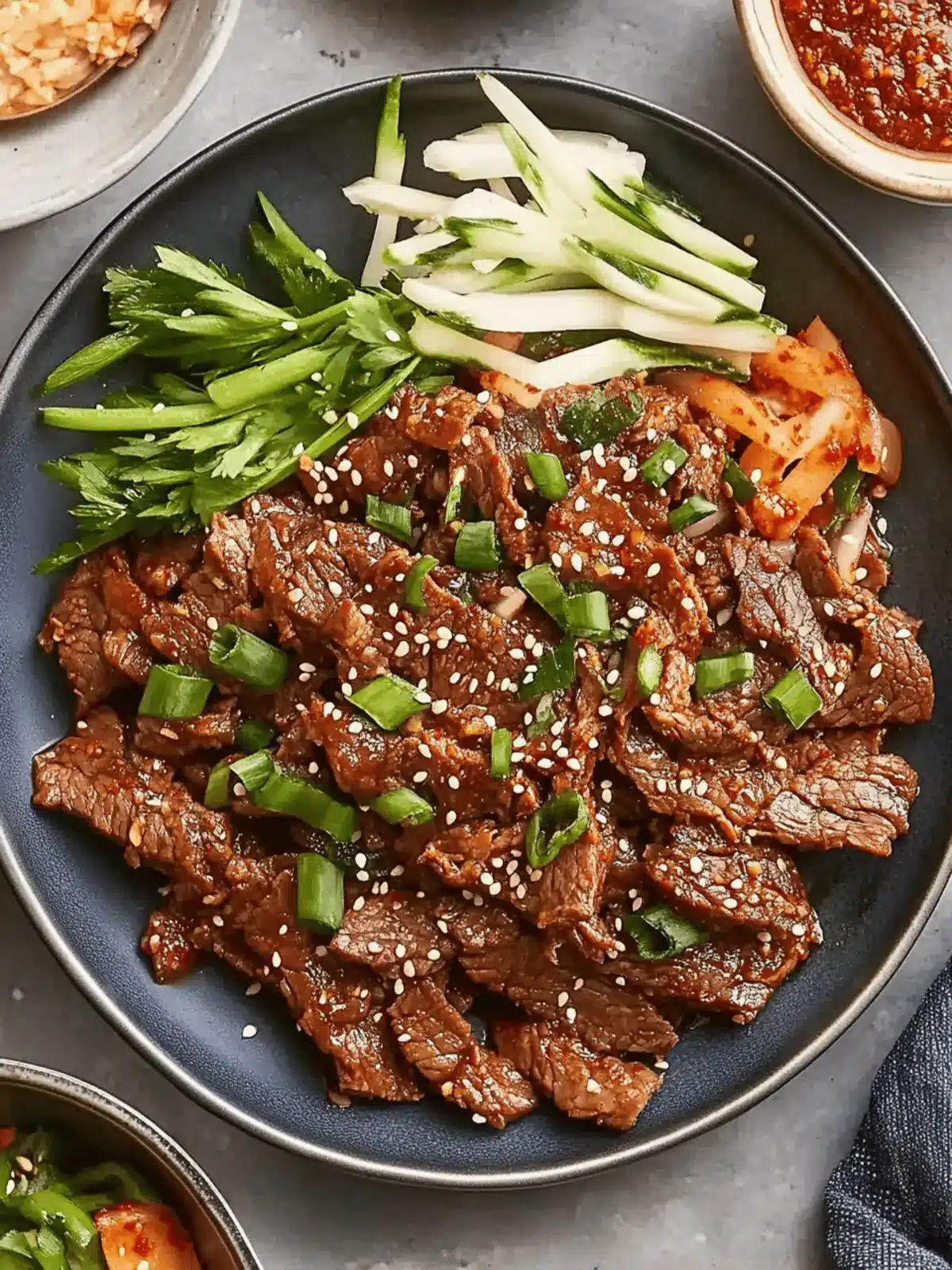There’s something truly exhilarating about the rush of flavors you get from Korean Beef Bulgogi, and making it at home unlocks a world of savory delights that fast food just can’t match. Picture this: the sweet, aromatic scent of a beautifully marinated rib eye steak sizzling away in a hot pan, pulling you in with its promise of tender, juicy perfection. As I prepped for a cozy evening, I found myself yearning for a dish that could easily elevate my weeknight dinner without the fuss of complicated cooking techniques—this recipe was just the answer.
With a handful of simple ingredients, including grated pear and the bold kick of gochujang, you can whip up a dish that feels luxurious yet is surprisingly straightforward. Whether you’re wanting to impress guests or simply treat yourself and your family to something special, this marinated steak delivers flavor and enjoyment in each bite. Join me as I guide you through the steps to create this mouthwatering masterpiece—your taste buds will thank you!
Why is Korean Beef Bulgogi a Must-Try?
Flavorful Fusion: The blend of sweet pear and savory soy sauce creates a marinade that penetrates the meat for rich taste in every bite.
Quick Cooking: Ready in just 36 minutes, this recipe is perfect for busy weeknights without sacrificing flavor.
Impressive Presentation: When served, the beautifully charred steaks are a feast for the eyes and a delight for your guests.
Unique Ingredients: Gochujang adds an authentic Korean kick, while sesame oil lends a subtle nuttiness that perfectly complements the dish.
Versatile Dish: Serve it with rice, in lettuce wraps, or as part of a larger meal for endless meal possibilities.
Indulging in this Korean Beef Bulgogi makes every dinner feel special—perfect for anyone longing for homemade goodness.
Korean Beef Bulgogi Ingredients
Unlock the secret to your new favorite dish!
For the Marinade
• Boneless rib eye steak – gives the dish a tender and juicy texture that absorbs flavors beautifully.
• Grated pear – provides a natural sweetness that balances the savory notes of the marinade.
• Reduced sodium soy sauce – keeps the dish savory without overwhelming saltiness.
• Brown sugar – enhances the caramelization during cooking for a delightful crust.
• Toasted sesame oil – adds a rich, nutty flavor that’s quintessential in Korean cuisine.
• Garlic – infuses a warm, aromatic kick that complements the other ingredients.
• Freshly grated ginger – offers a zesty freshness that brightens the marinade.
• Gochujang – brings an authentic Korean heat that elevates the dish’s overall flavor profile.
For Cooking
• Vegetable oil – used for frying, it helps achieve a perfect sear on the steak.
• Green onions – for garnish, adding a fresh, crisp bite to your finished dish.
• Toasted sesame seeds – sprinkle for a decorative touch and added texture.
Gather these ingredients and let the magic of Korean Beef Bulgogi transform your kitchen into a cozy haven of flavors!
How to Make Korean Beef Bulgogi
-
Prep the Steak: Wrap the boneless rib eye steak in plastic wrap and freeze it for 30 minutes. This will help you slice it easily into 1/4-inch thick pieces once you unwrap it.
-
Mix the Marinade: In a medium bowl, combine the grated pear, reduced sodium soy sauce, brown sugar, toasted sesame oil, minced garlic, freshly grated ginger, and gochujang. This marinade is the heart of your Korean Beef Bulgogi, so mix well!
-
Marinate the Steak: Place the sliced steak in a gallon size Ziploc bag along with the marinade. Seal the bag and marinate for at least 2 hours or overnight, turning it occasionally to ensure every piece is coated beautifully.
-
Heat the Grill Pan: Preheat a cast iron grill pan over medium-high heat and add 1 tablespoon of vegetable oil. Make sure it’s nice and hot before adding the steak!
-
Cook the Beef: Working in batches, add the marinated steak to the grill pan in a single layer. Cook for about 2-3 minutes per side until the edges are nicely charred and cooked through, flipping once. Repeat this with the remaining oil and steak until all pieces are seared.
Optional: Garnish with sliced green onions and toasted sesame seeds for an extra pop of flavor!
Exact quantities are listed in the recipe card below.
Korean Beef Bulgogi Variations
Unleash your creativity and make this dish your own with exciting twists and substitutions that elevate the flavors even further!
-
Gluten-Free: Substitute the reduced sodium soy sauce for tamari or coconut aminos to keep it gluten-free without sacrificing taste.
-
Sweet Spice: Add a dash of honey or agave syrup alongside the brown sugar for an extra layer of sweetness, perfectly balancing the heat from gochujang.
-
Vegetarian Option: Swap the rib eye with firm tofu or portobello mushrooms, marinating them in the same rich flavors for a delectable plant-based treat. Enjoying a meatless meal doesn’t have to be boring!
-
Herbed Delight: Toss in freshly chopped cilantro or basil into the marinade for a refreshing herbal twist that meshes beautifully with the savory flavors.
-
Smoky Flavor: Incorporate smoked paprika or chipotle powder to give your marinade a smoky edge that complements the charred beef exceptionally well.
-
Extra Crunch: Consider adding thinly sliced bell peppers or carrots to the grill pan during cooking for an added crunch and vibrant color against the marinated beef.
-
Increased Heat: Want it spicier? Stir in more gochujang or a splash of Sriracha to the marinade, ramping up the heat to suit your spice tolerance.
-
Citrus Zing: Squeeze a bit of fresh lime or lemon juice over the cooked beef before serving for a bright finish that enhances the dish’s overall zest.
Each of these variations invites you to experiment and make this Korean Beef Bulgogi uniquely yours, amplifying its enjoyment at your dinner table!
Make Ahead Options
These Korean Beef Bulgogi are perfect for busy home cooks looking to save time during the week! You can marinate the sliced rib eye steak in the sauce for up to 24 hours, allowing the flavors to intensify. Just combine all marinade ingredients (grated pear, soy sauce, brown sugar, sesame oil, garlic, ginger, and gochujang) and let the steak soak overnight in the refrigerator. For optimal results, make sure to store the marinated steak in an airtight container to maintain its quality. When you’re ready to cook, simply heat your grill pan and proceed with the cooking instructions. Enjoy tender, flavorful Korean Beef Bulgogi with minimal effort on busy nights!
Expert Tips for Korean Beef Bulgogi
-
Choose Quality Steak: Use a boneless rib eye for the best marbling, resulting in a tender and juicy Korean Beef Bulgogi.
-
Marinate Longer: For maximum flavor infusion, consider marinating overnight, allowing the marinade to penetrate deeper into the meat.
-
Slicing Technique: Remember to slice the steak against the grain for optimal tenderness; this prevents chewy bites and ensures a melt-in-your-mouth experience.
-
High Heat Cooking: Ensure your grill pan is sufficiently hot before adding the beef; this helps achieve that beautiful char and seals in the juices.
-
Don’t Overcrowd: Cook in batches to avoid steaming; placing too much meat in the pan at once can prevent that ideal sear.
Each of these tips will guide you towards a truly spectacular Korean Beef Bulgogi that will impress your family and friends alike!
How to Store and Freeze Korean Beef Bulgogi
Fridge: Store marinated beef in an airtight container for up to 3 days. This way, the flavors will continue to develop while keeping the meat fresh.
Freezer: If you have leftover cooked beef, place it in a freezer-safe container and store for up to 3 months. Thaw in the fridge before reheating.
Reheating: To reheat, warm gently in a skillet over medium heat for a few minutes, or microwave on medium power until heated through. Enjoy your Korean Beef Bulgogi!
What to Serve with Marinated Rib Eye Steak?
Creating a complete meal around your marinated rib eye steak can elevate your dining experience to new heights!
- Steamed Jasmine Rice: Fluffy rice soaks up the rich marinade while balancing the savory flavors of the steak.
- Spicy Kimchi: This fermented side adds a punch of heat and tang, enhancing the overall umami experience.
- Crispy Roasted Brussels Sprouts: Their caramelized edges provide a delightful crunch that contrasts beautifully with the tender steak.
- Garlic Butter Noodles: Simple yet indulgent, these noodles offer a smooth, buttery finish that embraces all the flavors on your plate.
- Slaw with Ginger Dressing: A crunchy slaw dressed in a ginger vinaigrette brings freshness and acidity that brightens the meal.
- Sesame Green Beans: Stir-fried green beans tossed with sesame seeds provide a snappy, vibrant side that adds color and nutrition.
- Chilled Sake or Soju: Sip on this Japanese or Korean liquor to complement the rich, bold flavors of your steak beautifully.
- Chocolate Lava Cake: For dessert, this rich cake makes a perfect ending, contrasting the savory main with an indulgent sweetness.
Outfitting your table with these delightful pairings makes every bite of your marinated rib eye steak even more special!
Marinated Rib Eye Steak Recipe FAQs
What kind of rib eye steak should I use?
Absolutely! For the best results, look for a boneless rib eye steak with good marbling. The marbling will melt during cooking, making the meat tender and juicy. A fresh cut of steak will absorb the marinade beautifully and enhance the flavors.
How do I store the marinated rib eye steak?
You can store the marinated steak in an airtight container in the fridge for up to 3 days. This allows the flavors to deepen while ensuring the meat remains fresh. Make sure it’s well-sealed to prevent any odors from affecting the marinated steak.
Can I freeze the marinated rib eye steak?
Yes, you can! To freeze, place the marinated steak in a freezer-safe bag or container and seal it tightly. It can be stored in the freezer for up to 3 months. When you’re ready to enjoy it, thaw the steak in the fridge overnight before cooking to maintain its tenderness.
What should I do if my steak is tough after cooking?
Very! If your steak turns out chewy, it may be due to slicing against the grain, or not marinating long enough. Always slice against the grain, and for tougher cuts, let them marinate for at least overnight. If you find the steak tough after cooking, consider letting it rest for a few minutes before slicing; this can help redistribute the juices for a more tender result.
Can I use other ingredients to modify the marinade?
Definitely! If you’re looking for alternatives, feel free to experiment with different fruits for sweetness, like kiwi or apple, or try other spicy elements like sriracha instead of gochujang for a different flavor kick. This keeps things exciting and customizable to your taste preferences!
Is this recipe suitable for people with soy allergies?
Great question! If you have a soy allergy, you can substitute the reduced sodium soy sauce with coconut aminos or a homemade soy sauce alternative using chickpea or lentil broth mixed with a bit of vinegar for that savory edge. Always double-check all ingredient labels to ensure they’re safe for those with dietary restrictions.

Savory Korean Beef Bulgogi: A Flavor Explosion Awaits
Ingredients
Equipment
Method
- Wrap the boneless rib eye steak in plastic wrap and freeze it for 30 minutes.
- In a medium bowl, combine the grated pear, reduced sodium soy sauce, brown sugar, toasted sesame oil, minced garlic, freshly grated ginger, and gochujang.
- Place the sliced steak in a gallon size Ziploc bag along with the marinade. Seal the bag and marinate for at least 2 hours or overnight.
- Preheat a cast iron grill pan over medium-high heat and add 1 tablespoon of vegetable oil.
- Add the marinated steak to the grill pan in a single layer, cooking for about 2-3 minutes per side.
- Repeat this with the remaining oil and steak until all pieces are seared.
- Garnish with sliced green onions and toasted sesame seeds if desired.








